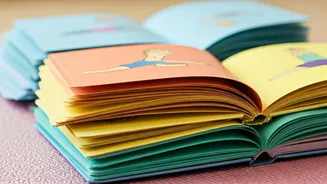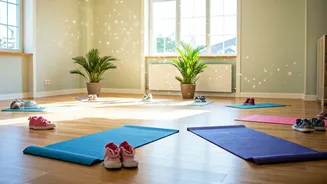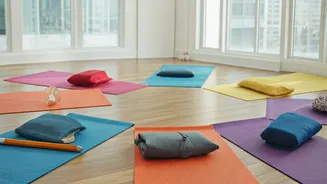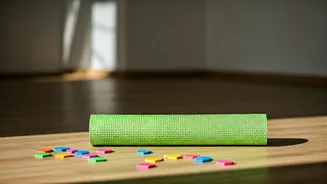Introduction to Yoga
Yoga, an ancient practice, is increasingly recognized for its benefits in enhancing both physical and mental well-being. For children, yoga offers a playful
and engaging approach to improve various cognitive functions. Unlike traditional exercises, yoga asanas combine physical postures with mindful breathing, fostering a holistic approach to health. These practices can help children develop better concentration, improve memory retention, and reduce stress levels. Incorporating yoga into a child's routine can create a positive impact on their academic performance and overall quality of life, making it a valuable addition to their daily activities. The gentle nature of yoga ensures it is suitable for various age groups and physical abilities, making it an inclusive practice.
The Importance of Memory
Memory plays a crucial role in a child's ability to learn and retain information, forming the foundation for academic success. Effective memory skills allow children to recall facts, understand concepts, and apply knowledge in different situations. In today's fast-paced world, where children are constantly exposed to information, having a strong memory is more important than ever. Enhanced memory contributes to improved problem-solving skills, better organizational abilities, and increased self-confidence. Children with strong memory capabilities are better equipped to handle academic challenges and manage their day-to-day activities efficiently. Furthermore, memory is not just about rote learning; it also involves critical thinking and the ability to connect new information with existing knowledge, facilitating deeper understanding and retention.
Mountain Pose (Tadasana)
Mountain Pose, or Tadasana, is a foundational yoga asana that improves posture and promotes a sense of grounding and stability. To perform this pose, children should stand tall with their feet firmly planted on the ground, toes pointing forward, and hands at their sides. They can focus on lengthening their spine and drawing their shoulders back, maintaining a straight posture. This pose encourages children to be aware of their body and provides a calming effect, improving focus and concentration. By practicing Mountain Pose regularly, children develop better balance and body awareness, which contributes to improved cognitive functions. This simple yet effective pose acts as a starting point for more complex asanas, offering a sense of calm and centeredness before starting other exercises.
Tree Pose (Vrksasana)
Tree Pose, also known as Vrksasana, is a balancing asana that promotes concentration and coordination. To begin, children can stand with their feet together, bringing their hands to the center of their chest in a prayer position. They can then lift one foot and place it on their inner thigh, either above or below the knee, avoiding direct contact with the knee. Children should maintain a straight spine and gaze at a fixed point to maintain balance. This asana enhances focus and increases body awareness, essential skills for academic success and daily life. Practicing Tree Pose improves children's ability to maintain equilibrium and develops their mental fortitude, which aids in handling challenges both in and outside of the classroom. With each attempt, they build resilience and confidence.
Warrior Pose (Virabhadrasana)
Warrior Pose or Virabhadrasana, builds strength and determination, also improving focus. Children begin by standing with their feet wide apart, turning one foot out 90 degrees and the other slightly in. They bend the front knee to a 90-degree angle, keeping the knee over the ankle, while extending their arms to the sides at shoulder height, gazing forward. This pose promotes physical strength and mental resilience, crucial attributes for children navigating various challenges. Warrior Pose boosts confidence and concentration, which are essential for academic achievement and personal growth. The practice also enhances balance and coordination. Regular practice helps children cultivate a sense of empowerment and self-assuredness, enabling them to approach life with greater determination.
Triangle Pose (Trikonasana)
Triangle Pose, or Trikonasana, stretches the body and enhances balance, also improving focus and memory. Children start in a wide stance, extending their arms to the sides, at shoulder height. They then bend to one side, reaching their hand towards their foot, while the other arm stretches upwards. This pose improves spatial awareness and promotes mental clarity. Trikonasana helps increase memory retention by stimulating the mind and body. The pose requires children to focus on their form, which improves concentration and helps them maintain a steady mind. Practicing Trikonasana regularly helps increase their body awareness and coordination, which supports cognitive functions. This asana allows children to feel the sensation of stretching and relaxing, which contributes to improved physical health.
Child’s Pose (Balasana)
Child’s Pose or Balasana, is a calming pose that can ease stress and improve focus. Children kneel on the floor and then lean forward, allowing their torso to rest on their thighs and their forehead on the ground. They can stretch their arms forward or place them alongside their body. This restorative pose allows children to relax and recover, clearing their minds and enhancing their ability to concentrate. Child’s Pose can reduce stress levels and induce a sense of calmness. It provides a peaceful respite, making it easier for children to focus and retain information. The posture gently stretches the back and hips while calming the mind, making it a great option for stress release.
Boat Pose (Paripurna Navasana)
Boat Pose or Paripurna Navasana, strengthens the core and enhances concentration. Children sit with their knees bent and feet lifted off the floor, balancing on their sit bones. They straighten their legs as much as possible, extending their arms forward parallel to the legs. This pose challenges the body and mind, helping to improve both physical and cognitive skills. Boat Pose aids in improving focus and memory because it requires balance and mental discipline. The core strength developed through this asana enhances the overall performance, allowing kids to improve their attention span. Regular practice also strengthens the core and boosts the body's energy levels.
Cobra Pose (Bhujangasana)
Cobra Pose, known as Bhujangasana, stimulates the mind and improves concentration. Children lie face down on the floor, placing their hands under their shoulders and lifting their upper body, keeping the lower body on the ground. This asana aids in reducing stress and fatigue, which contributes to clearer thinking. Cobra Pose invigorates the mind and body, promoting enhanced focus and memory. The stretching action can relieve tension and promote better cognitive function, improving a child's memory. Performing the Cobra Pose regularly can boost energy and concentration, resulting in improved academic performance and overall well-being.
Bridge Pose (Setu Bandhasana)
Bridge Pose, or Setu Bandhasana, promotes calmness and improves focus. Children lie on their back, bending their knees and placing their feet flat on the floor close to their hips. They then lift their hips off the floor, engaging their core muscles, and holding the position. This pose increases blood flow to the brain, enhancing memory and concentration. Bridge Pose reduces mental fatigue and helps improve learning and memory. The regular practice of Setu Bandhasana can improve both physical and mental well-being, enhancing their overall learning skills and performance. The exercise contributes to a healthier body and sharper mind by reducing the stress levels.













